MGT502 Business Communication: Globalization's Impact Annotated Bib
VerifiedAdded on 2022/07/28
|11
|2429
|19
Annotated Bibliography
AI Summary
This annotated bibliography examines the multifaceted impact of globalization on business communication. It analyzes ten sources, including journal articles and conference papers, to explore how globalization, ICT, and social media have reshaped communication strategies. The bibliography covers various aspects, such as the role of social media in information sharing, the impact of ICT on reducing transaction costs, and the barriers to cross-cultural communication. Key themes include the importance of effective communication strategies, the challenges of multilingualism, and the need for businesses to adapt to changing global environments. The sources provide insights into how businesses can navigate cross-cultural differences, leverage technology, and maintain competitiveness in the global marketplace. The annotated bibliography is a valuable resource for understanding the complexities of business communication in an increasingly interconnected world.

Student name
INSTITUTIONAL AFFILIATION(S)
PART A
INSTITUTIONAL AFFILIATION(S)
PART A
Paraphrase This Document
Need a fresh take? Get an instant paraphrase of this document with our AI Paraphraser
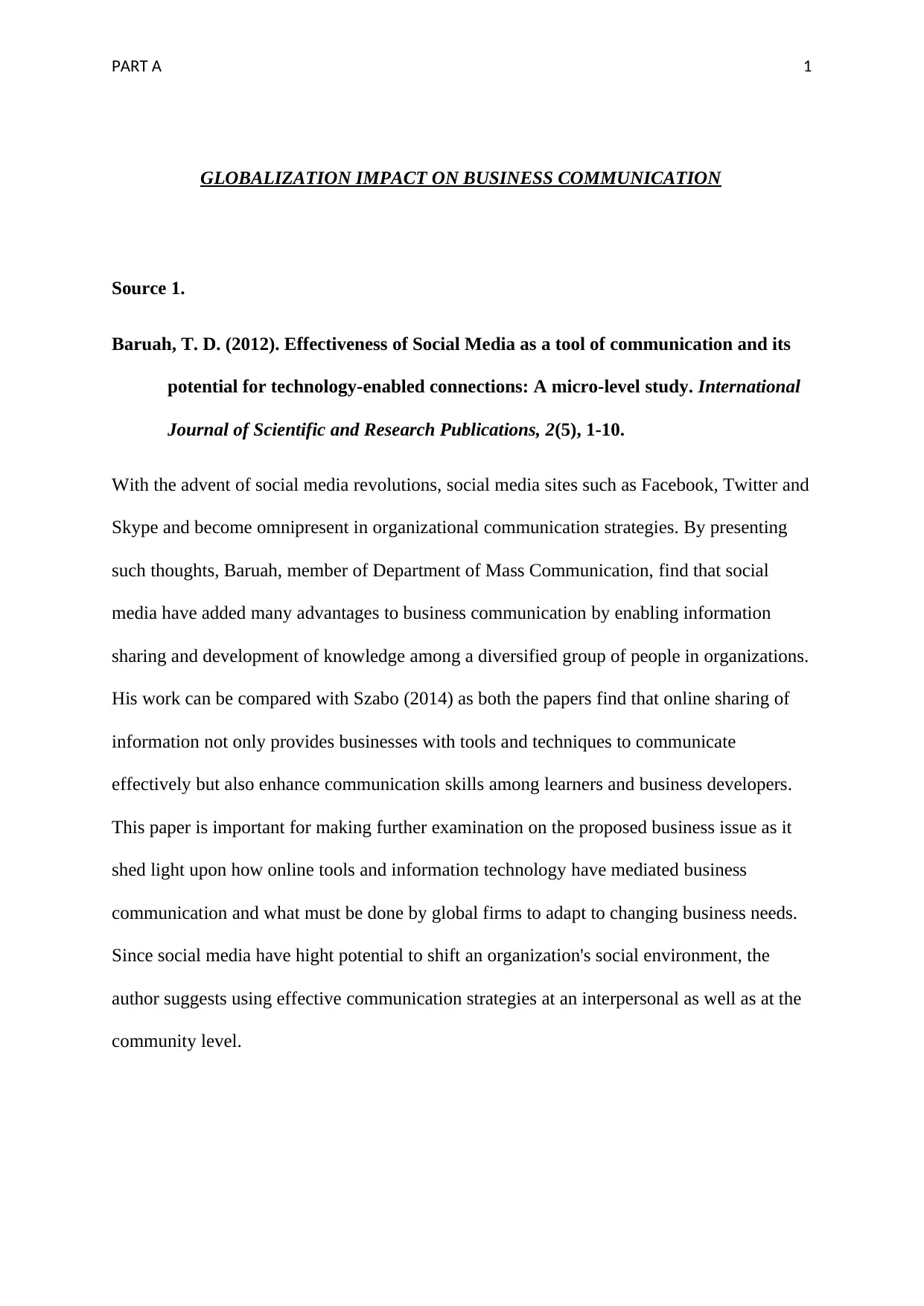
PART A 1
GLOBALIZATION IMPACT ON BUSINESS COMMUNICATION
Source 1.
Baruah, T. D. (2012). Effectiveness of Social Media as a tool of communication and its
potential for technology-enabled connections: A micro-level study. International
Journal of Scientific and Research Publications, 2(5), 1-10.
With the advent of social media revolutions, social media sites such as Facebook, Twitter and
Skype and become omnipresent in organizational communication strategies. By presenting
such thoughts, Baruah, member of Department of Mass Communication, find that social
media have added many advantages to business communication by enabling information
sharing and development of knowledge among a diversified group of people in organizations.
His work can be compared with Szabo (2014) as both the papers find that online sharing of
information not only provides businesses with tools and techniques to communicate
effectively but also enhance communication skills among learners and business developers.
This paper is important for making further examination on the proposed business issue as it
shed light upon how online tools and information technology have mediated business
communication and what must be done by global firms to adapt to changing business needs.
Since social media have hight potential to shift an organization's social environment, the
author suggests using effective communication strategies at an interpersonal as well as at the
community level.
GLOBALIZATION IMPACT ON BUSINESS COMMUNICATION
Source 1.
Baruah, T. D. (2012). Effectiveness of Social Media as a tool of communication and its
potential for technology-enabled connections: A micro-level study. International
Journal of Scientific and Research Publications, 2(5), 1-10.
With the advent of social media revolutions, social media sites such as Facebook, Twitter and
Skype and become omnipresent in organizational communication strategies. By presenting
such thoughts, Baruah, member of Department of Mass Communication, find that social
media have added many advantages to business communication by enabling information
sharing and development of knowledge among a diversified group of people in organizations.
His work can be compared with Szabo (2014) as both the papers find that online sharing of
information not only provides businesses with tools and techniques to communicate
effectively but also enhance communication skills among learners and business developers.
This paper is important for making further examination on the proposed business issue as it
shed light upon how online tools and information technology have mediated business
communication and what must be done by global firms to adapt to changing business needs.
Since social media have hight potential to shift an organization's social environment, the
author suggests using effective communication strategies at an interpersonal as well as at the
community level.
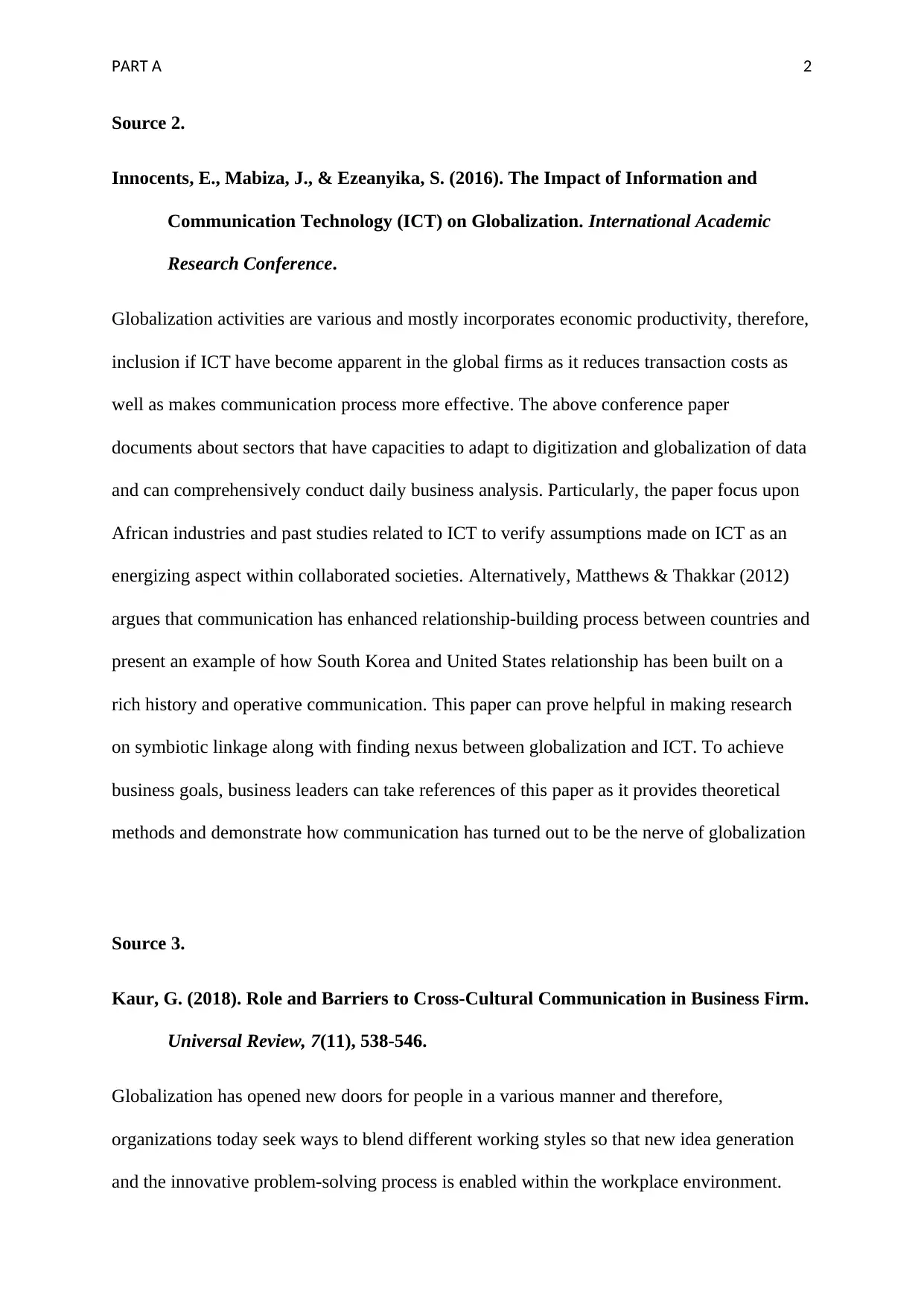
PART A 2
Source 2.
Innocents, E., Mabiza, J., & Ezeanyika, S. (2016). The Impact of Information and
Communication Technology (ICT) on Globalization. International Academic
Research Conference.
Globalization activities are various and mostly incorporates economic productivity, therefore,
inclusion if ICT have become apparent in the global firms as it reduces transaction costs as
well as makes communication process more effective. The above conference paper
documents about sectors that have capacities to adapt to digitization and globalization of data
and can comprehensively conduct daily business analysis. Particularly, the paper focus upon
African industries and past studies related to ICT to verify assumptions made on ICT as an
energizing aspect within collaborated societies. Alternatively, Matthews & Thakkar (2012)
argues that communication has enhanced relationship-building process between countries and
present an example of how South Korea and United States relationship has been built on a
rich history and operative communication. This paper can prove helpful in making research
on symbiotic linkage along with finding nexus between globalization and ICT. To achieve
business goals, business leaders can take references of this paper as it provides theoretical
methods and demonstrate how communication has turned out to be the nerve of globalization
Source 3.
Kaur, G. (2018). Role and Barriers to Cross-Cultural Communication in Business Firm.
Universal Review, 7(11), 538-546.
Globalization has opened new doors for people in a various manner and therefore,
organizations today seek ways to blend different working styles so that new idea generation
and the innovative problem-solving process is enabled within the workplace environment.
Source 2.
Innocents, E., Mabiza, J., & Ezeanyika, S. (2016). The Impact of Information and
Communication Technology (ICT) on Globalization. International Academic
Research Conference.
Globalization activities are various and mostly incorporates economic productivity, therefore,
inclusion if ICT have become apparent in the global firms as it reduces transaction costs as
well as makes communication process more effective. The above conference paper
documents about sectors that have capacities to adapt to digitization and globalization of data
and can comprehensively conduct daily business analysis. Particularly, the paper focus upon
African industries and past studies related to ICT to verify assumptions made on ICT as an
energizing aspect within collaborated societies. Alternatively, Matthews & Thakkar (2012)
argues that communication has enhanced relationship-building process between countries and
present an example of how South Korea and United States relationship has been built on a
rich history and operative communication. This paper can prove helpful in making research
on symbiotic linkage along with finding nexus between globalization and ICT. To achieve
business goals, business leaders can take references of this paper as it provides theoretical
methods and demonstrate how communication has turned out to be the nerve of globalization
Source 3.
Kaur, G. (2018). Role and Barriers to Cross-Cultural Communication in Business Firm.
Universal Review, 7(11), 538-546.
Globalization has opened new doors for people in a various manner and therefore,
organizations today seek ways to blend different working styles so that new idea generation
and the innovative problem-solving process is enabled within the workplace environment.
⊘ This is a preview!⊘
Do you want full access?
Subscribe today to unlock all pages.

Trusted by 1+ million students worldwide
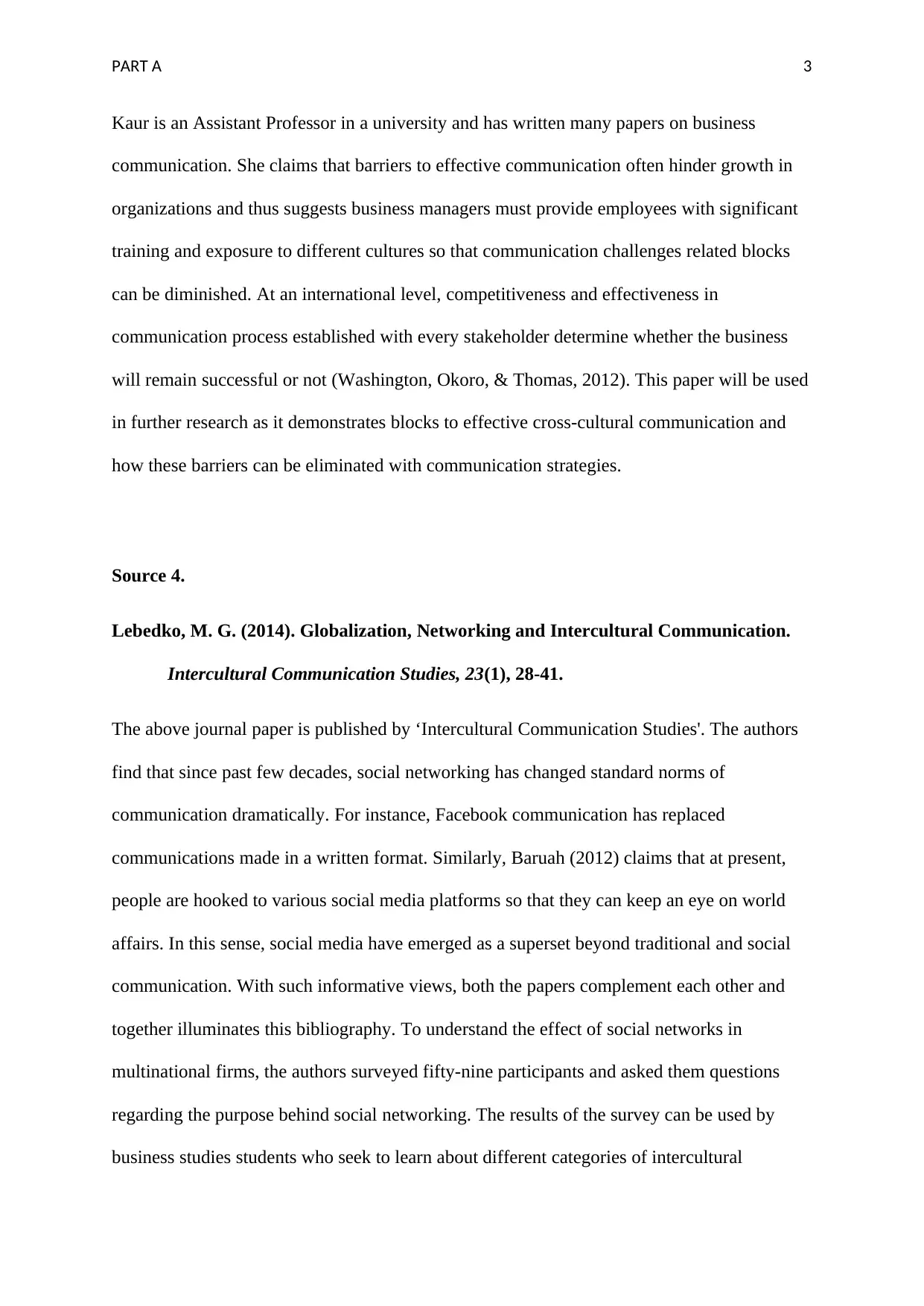
PART A 3
Kaur is an Assistant Professor in a university and has written many papers on business
communication. She claims that barriers to effective communication often hinder growth in
organizations and thus suggests business managers must provide employees with significant
training and exposure to different cultures so that communication challenges related blocks
can be diminished. At an international level, competitiveness and effectiveness in
communication process established with every stakeholder determine whether the business
will remain successful or not (Washington, Okoro, & Thomas, 2012). This paper will be used
in further research as it demonstrates blocks to effective cross-cultural communication and
how these barriers can be eliminated with communication strategies.
Source 4.
Lebedko, M. G. (2014). Globalization, Networking and Intercultural Communication.
Intercultural Communication Studies, 23(1), 28-41.
The above journal paper is published by ‘Intercultural Communication Studies'. The authors
find that since past few decades, social networking has changed standard norms of
communication dramatically. For instance, Facebook communication has replaced
communications made in a written format. Similarly, Baruah (2012) claims that at present,
people are hooked to various social media platforms so that they can keep an eye on world
affairs. In this sense, social media have emerged as a superset beyond traditional and social
communication. With such informative views, both the papers complement each other and
together illuminates this bibliography. To understand the effect of social networks in
multinational firms, the authors surveyed fifty-nine participants and asked them questions
regarding the purpose behind social networking. The results of the survey can be used by
business studies students who seek to learn about different categories of intercultural
Kaur is an Assistant Professor in a university and has written many papers on business
communication. She claims that barriers to effective communication often hinder growth in
organizations and thus suggests business managers must provide employees with significant
training and exposure to different cultures so that communication challenges related blocks
can be diminished. At an international level, competitiveness and effectiveness in
communication process established with every stakeholder determine whether the business
will remain successful or not (Washington, Okoro, & Thomas, 2012). This paper will be used
in further research as it demonstrates blocks to effective cross-cultural communication and
how these barriers can be eliminated with communication strategies.
Source 4.
Lebedko, M. G. (2014). Globalization, Networking and Intercultural Communication.
Intercultural Communication Studies, 23(1), 28-41.
The above journal paper is published by ‘Intercultural Communication Studies'. The authors
find that since past few decades, social networking has changed standard norms of
communication dramatically. For instance, Facebook communication has replaced
communications made in a written format. Similarly, Baruah (2012) claims that at present,
people are hooked to various social media platforms so that they can keep an eye on world
affairs. In this sense, social media have emerged as a superset beyond traditional and social
communication. With such informative views, both the papers complement each other and
together illuminates this bibliography. To understand the effect of social networks in
multinational firms, the authors surveyed fifty-nine participants and asked them questions
regarding the purpose behind social networking. The results of the survey can be used by
business studies students who seek to learn about different categories of intercultural
Paraphrase This Document
Need a fresh take? Get an instant paraphrase of this document with our AI Paraphraser
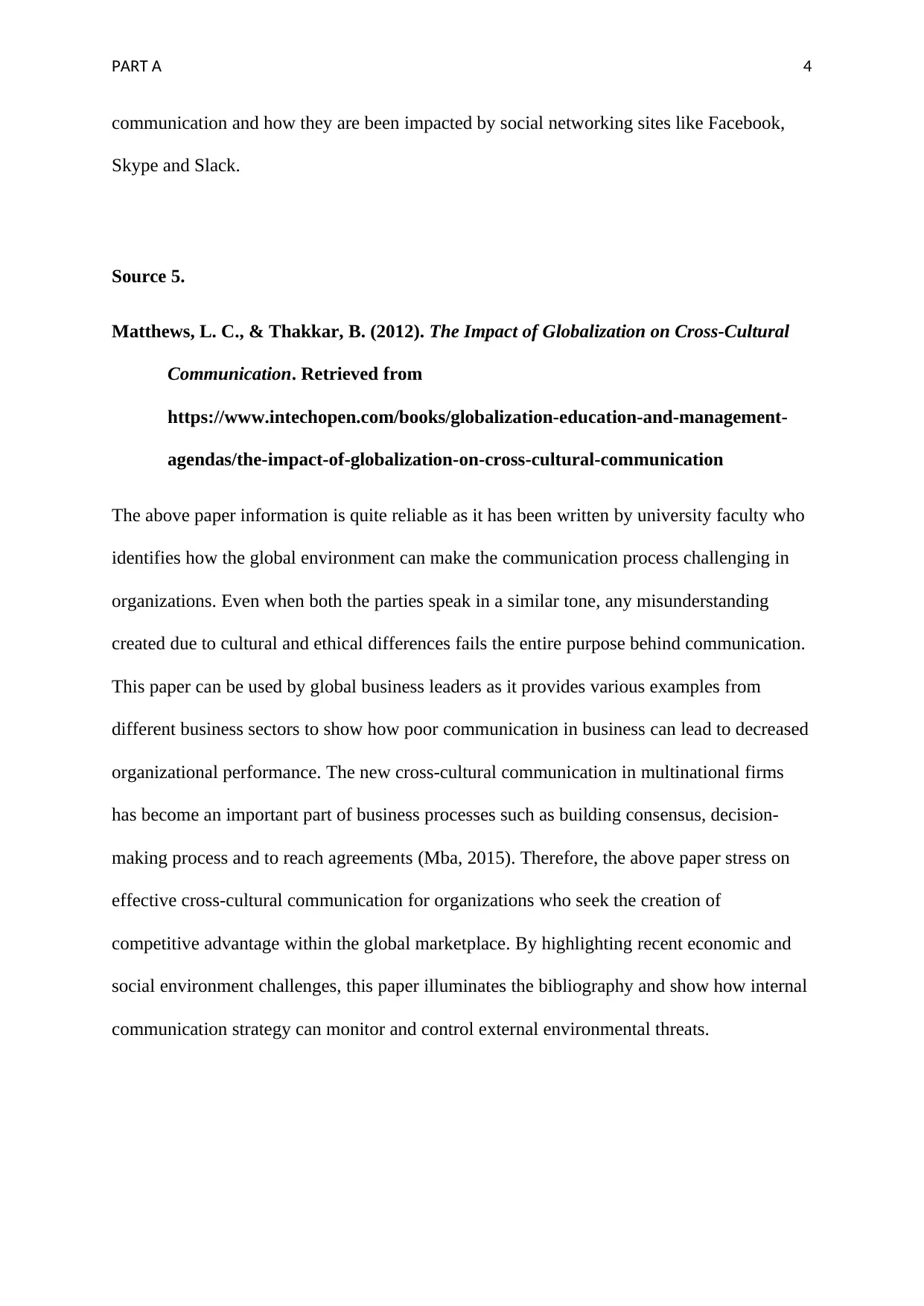
PART A 4
communication and how they are been impacted by social networking sites like Facebook,
Skype and Slack.
Source 5.
Matthews, L. C., & Thakkar, B. (2012). The Impact of Globalization on Cross-Cultural
Communication. Retrieved from
https://www.intechopen.com/books/globalization-education-and-management-
agendas/the-impact-of-globalization-on-cross-cultural-communication
The above paper information is quite reliable as it has been written by university faculty who
identifies how the global environment can make the communication process challenging in
organizations. Even when both the parties speak in a similar tone, any misunderstanding
created due to cultural and ethical differences fails the entire purpose behind communication.
This paper can be used by global business leaders as it provides various examples from
different business sectors to show how poor communication in business can lead to decreased
organizational performance. The new cross-cultural communication in multinational firms
has become an important part of business processes such as building consensus, decision-
making process and to reach agreements (Mba, 2015). Therefore, the above paper stress on
effective cross-cultural communication for organizations who seek the creation of
competitive advantage within the global marketplace. By highlighting recent economic and
social environment challenges, this paper illuminates the bibliography and show how internal
communication strategy can monitor and control external environmental threats.
communication and how they are been impacted by social networking sites like Facebook,
Skype and Slack.
Source 5.
Matthews, L. C., & Thakkar, B. (2012). The Impact of Globalization on Cross-Cultural
Communication. Retrieved from
https://www.intechopen.com/books/globalization-education-and-management-
agendas/the-impact-of-globalization-on-cross-cultural-communication
The above paper information is quite reliable as it has been written by university faculty who
identifies how the global environment can make the communication process challenging in
organizations. Even when both the parties speak in a similar tone, any misunderstanding
created due to cultural and ethical differences fails the entire purpose behind communication.
This paper can be used by global business leaders as it provides various examples from
different business sectors to show how poor communication in business can lead to decreased
organizational performance. The new cross-cultural communication in multinational firms
has become an important part of business processes such as building consensus, decision-
making process and to reach agreements (Mba, 2015). Therefore, the above paper stress on
effective cross-cultural communication for organizations who seek the creation of
competitive advantage within the global marketplace. By highlighting recent economic and
social environment challenges, this paper illuminates the bibliography and show how internal
communication strategy can monitor and control external environmental threats.
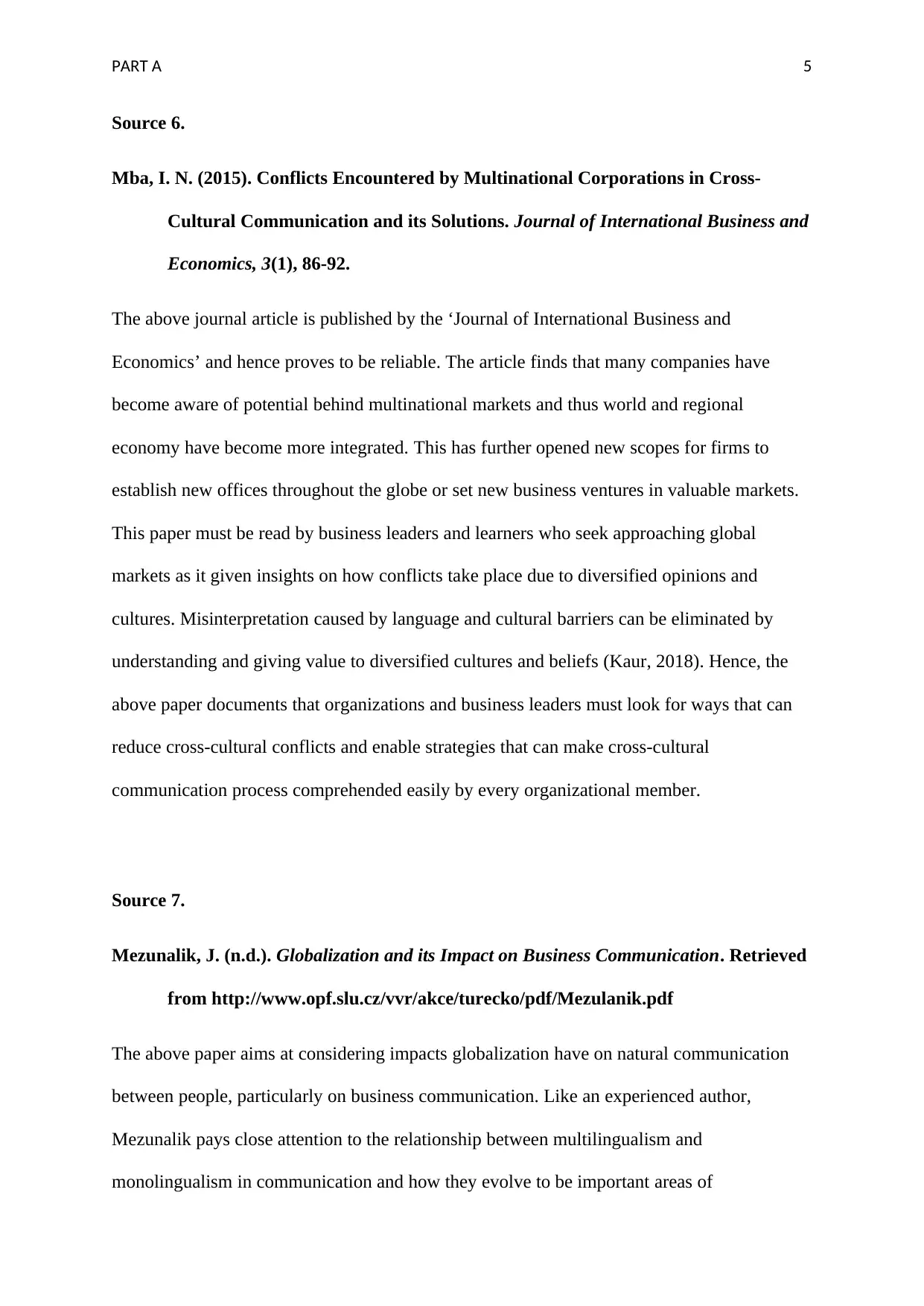
PART A 5
Source 6.
Mba, I. N. (2015). Conflicts Encountered by Multinational Corporations in Cross-
Cultural Communication and its Solutions. Journal of International Business and
Economics, 3(1), 86-92.
The above journal article is published by the ‘Journal of International Business and
Economics’ and hence proves to be reliable. The article finds that many companies have
become aware of potential behind multinational markets and thus world and regional
economy have become more integrated. This has further opened new scopes for firms to
establish new offices throughout the globe or set new business ventures in valuable markets.
This paper must be read by business leaders and learners who seek approaching global
markets as it given insights on how conflicts take place due to diversified opinions and
cultures. Misinterpretation caused by language and cultural barriers can be eliminated by
understanding and giving value to diversified cultures and beliefs (Kaur, 2018). Hence, the
above paper documents that organizations and business leaders must look for ways that can
reduce cross-cultural conflicts and enable strategies that can make cross-cultural
communication process comprehended easily by every organizational member.
Source 7.
Mezunalik, J. (n.d.). Globalization and its Impact on Business Communication. Retrieved
from http://www.opf.slu.cz/vvr/akce/turecko/pdf/Mezulanik.pdf
The above paper aims at considering impacts globalization have on natural communication
between people, particularly on business communication. Like an experienced author,
Mezunalik pays close attention to the relationship between multilingualism and
monolingualism in communication and how they evolve to be important areas of
Source 6.
Mba, I. N. (2015). Conflicts Encountered by Multinational Corporations in Cross-
Cultural Communication and its Solutions. Journal of International Business and
Economics, 3(1), 86-92.
The above journal article is published by the ‘Journal of International Business and
Economics’ and hence proves to be reliable. The article finds that many companies have
become aware of potential behind multinational markets and thus world and regional
economy have become more integrated. This has further opened new scopes for firms to
establish new offices throughout the globe or set new business ventures in valuable markets.
This paper must be read by business leaders and learners who seek approaching global
markets as it given insights on how conflicts take place due to diversified opinions and
cultures. Misinterpretation caused by language and cultural barriers can be eliminated by
understanding and giving value to diversified cultures and beliefs (Kaur, 2018). Hence, the
above paper documents that organizations and business leaders must look for ways that can
reduce cross-cultural conflicts and enable strategies that can make cross-cultural
communication process comprehended easily by every organizational member.
Source 7.
Mezunalik, J. (n.d.). Globalization and its Impact on Business Communication. Retrieved
from http://www.opf.slu.cz/vvr/akce/turecko/pdf/Mezulanik.pdf
The above paper aims at considering impacts globalization have on natural communication
between people, particularly on business communication. Like an experienced author,
Mezunalik pays close attention to the relationship between multilingualism and
monolingualism in communication and how they evolve to be important areas of
⊘ This is a preview!⊘
Do you want full access?
Subscribe today to unlock all pages.

Trusted by 1+ million students worldwide
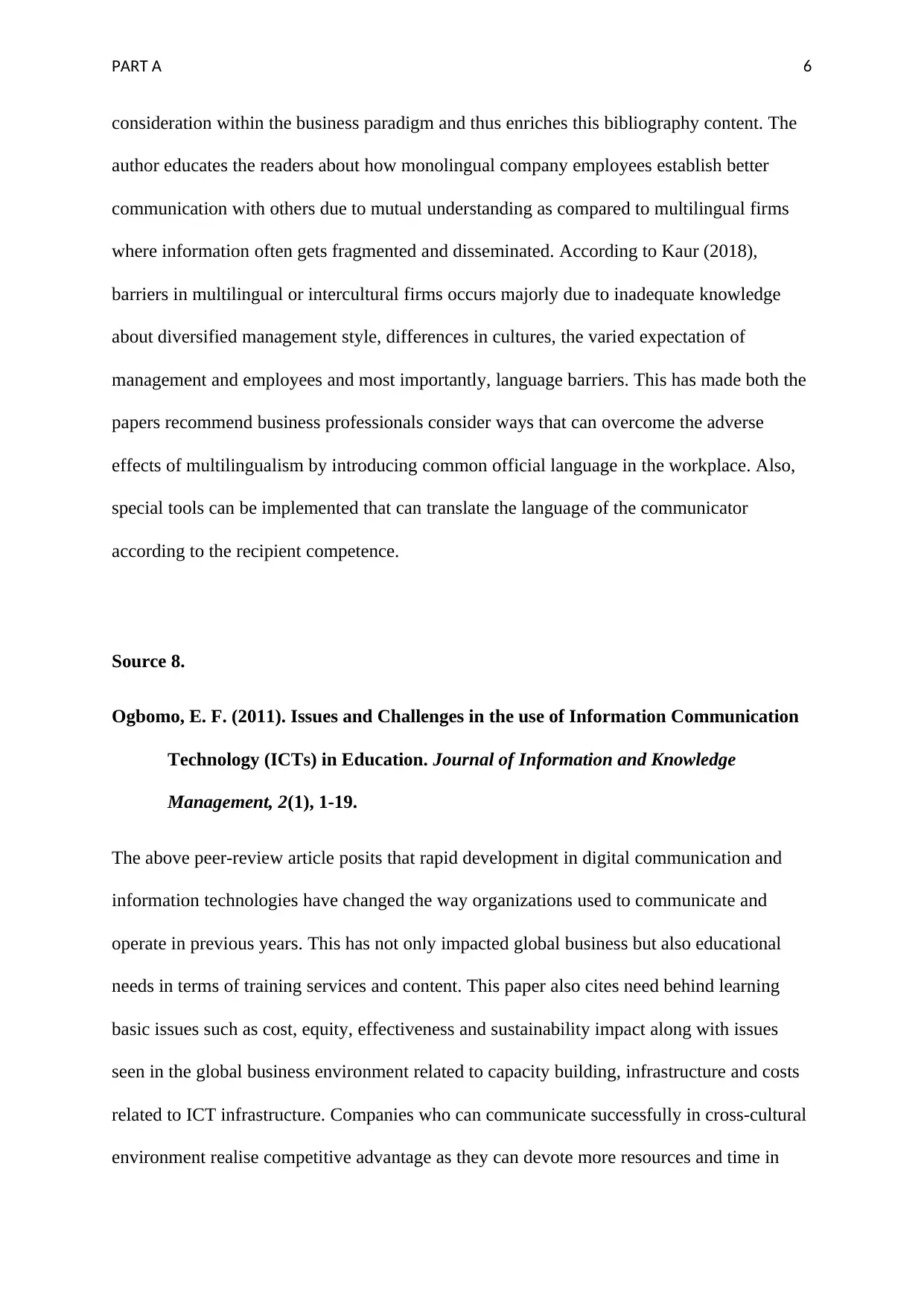
PART A 6
consideration within the business paradigm and thus enriches this bibliography content. The
author educates the readers about how monolingual company employees establish better
communication with others due to mutual understanding as compared to multilingual firms
where information often gets fragmented and disseminated. According to Kaur (2018),
barriers in multilingual or intercultural firms occurs majorly due to inadequate knowledge
about diversified management style, differences in cultures, the varied expectation of
management and employees and most importantly, language barriers. This has made both the
papers recommend business professionals consider ways that can overcome the adverse
effects of multilingualism by introducing common official language in the workplace. Also,
special tools can be implemented that can translate the language of the communicator
according to the recipient competence.
Source 8.
Ogbomo, E. F. (2011). Issues and Challenges in the use of Information Communication
Technology (ICTs) in Education. Journal of Information and Knowledge
Management, 2(1), 1-19.
The above peer-review article posits that rapid development in digital communication and
information technologies have changed the way organizations used to communicate and
operate in previous years. This has not only impacted global business but also educational
needs in terms of training services and content. This paper also cites need behind learning
basic issues such as cost, equity, effectiveness and sustainability impact along with issues
seen in the global business environment related to capacity building, infrastructure and costs
related to ICT infrastructure. Companies who can communicate successfully in cross-cultural
environment realise competitive advantage as they can devote more resources and time in
consideration within the business paradigm and thus enriches this bibliography content. The
author educates the readers about how monolingual company employees establish better
communication with others due to mutual understanding as compared to multilingual firms
where information often gets fragmented and disseminated. According to Kaur (2018),
barriers in multilingual or intercultural firms occurs majorly due to inadequate knowledge
about diversified management style, differences in cultures, the varied expectation of
management and employees and most importantly, language barriers. This has made both the
papers recommend business professionals consider ways that can overcome the adverse
effects of multilingualism by introducing common official language in the workplace. Also,
special tools can be implemented that can translate the language of the communicator
according to the recipient competence.
Source 8.
Ogbomo, E. F. (2011). Issues and Challenges in the use of Information Communication
Technology (ICTs) in Education. Journal of Information and Knowledge
Management, 2(1), 1-19.
The above peer-review article posits that rapid development in digital communication and
information technologies have changed the way organizations used to communicate and
operate in previous years. This has not only impacted global business but also educational
needs in terms of training services and content. This paper also cites need behind learning
basic issues such as cost, equity, effectiveness and sustainability impact along with issues
seen in the global business environment related to capacity building, infrastructure and costs
related to ICT infrastructure. Companies who can communicate successfully in cross-cultural
environment realise competitive advantage as they can devote more resources and time in
Paraphrase This Document
Need a fresh take? Get an instant paraphrase of this document with our AI Paraphraser
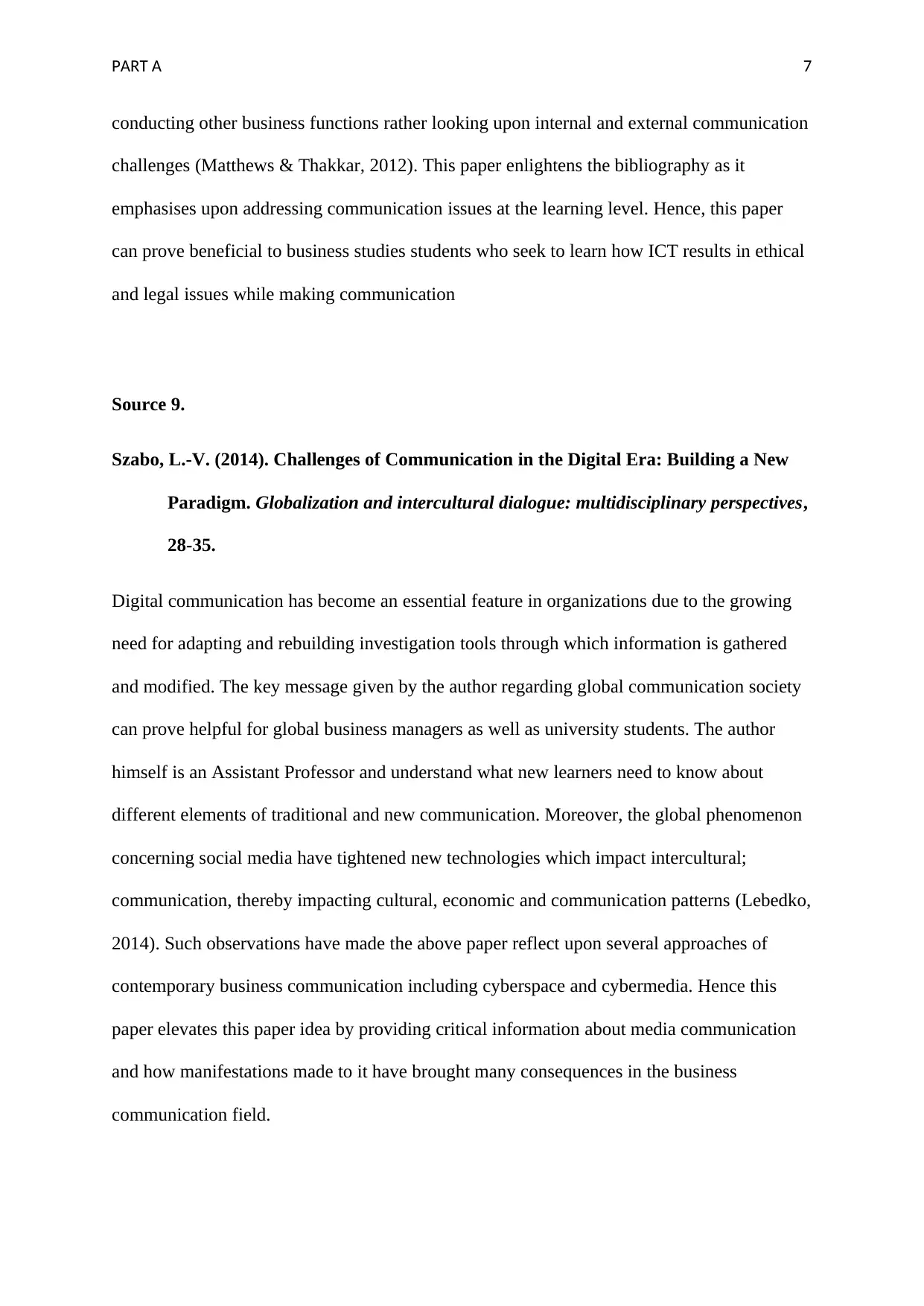
PART A 7
conducting other business functions rather looking upon internal and external communication
challenges (Matthews & Thakkar, 2012). This paper enlightens the bibliography as it
emphasises upon addressing communication issues at the learning level. Hence, this paper
can prove beneficial to business studies students who seek to learn how ICT results in ethical
and legal issues while making communication
Source 9.
Szabo, L.-V. (2014). Challenges of Communication in the Digital Era: Building a New
Paradigm. Globalization and intercultural dialogue: multidisciplinary perspectives,
28-35.
Digital communication has become an essential feature in organizations due to the growing
need for adapting and rebuilding investigation tools through which information is gathered
and modified. The key message given by the author regarding global communication society
can prove helpful for global business managers as well as university students. The author
himself is an Assistant Professor and understand what new learners need to know about
different elements of traditional and new communication. Moreover, the global phenomenon
concerning social media have tightened new technologies which impact intercultural;
communication, thereby impacting cultural, economic and communication patterns (Lebedko,
2014). Such observations have made the above paper reflect upon several approaches of
contemporary business communication including cyberspace and cybermedia. Hence this
paper elevates this paper idea by providing critical information about media communication
and how manifestations made to it have brought many consequences in the business
communication field.
conducting other business functions rather looking upon internal and external communication
challenges (Matthews & Thakkar, 2012). This paper enlightens the bibliography as it
emphasises upon addressing communication issues at the learning level. Hence, this paper
can prove beneficial to business studies students who seek to learn how ICT results in ethical
and legal issues while making communication
Source 9.
Szabo, L.-V. (2014). Challenges of Communication in the Digital Era: Building a New
Paradigm. Globalization and intercultural dialogue: multidisciplinary perspectives,
28-35.
Digital communication has become an essential feature in organizations due to the growing
need for adapting and rebuilding investigation tools through which information is gathered
and modified. The key message given by the author regarding global communication society
can prove helpful for global business managers as well as university students. The author
himself is an Assistant Professor and understand what new learners need to know about
different elements of traditional and new communication. Moreover, the global phenomenon
concerning social media have tightened new technologies which impact intercultural;
communication, thereby impacting cultural, economic and communication patterns (Lebedko,
2014). Such observations have made the above paper reflect upon several approaches of
contemporary business communication including cyberspace and cybermedia. Hence this
paper elevates this paper idea by providing critical information about media communication
and how manifestations made to it have brought many consequences in the business
communication field.
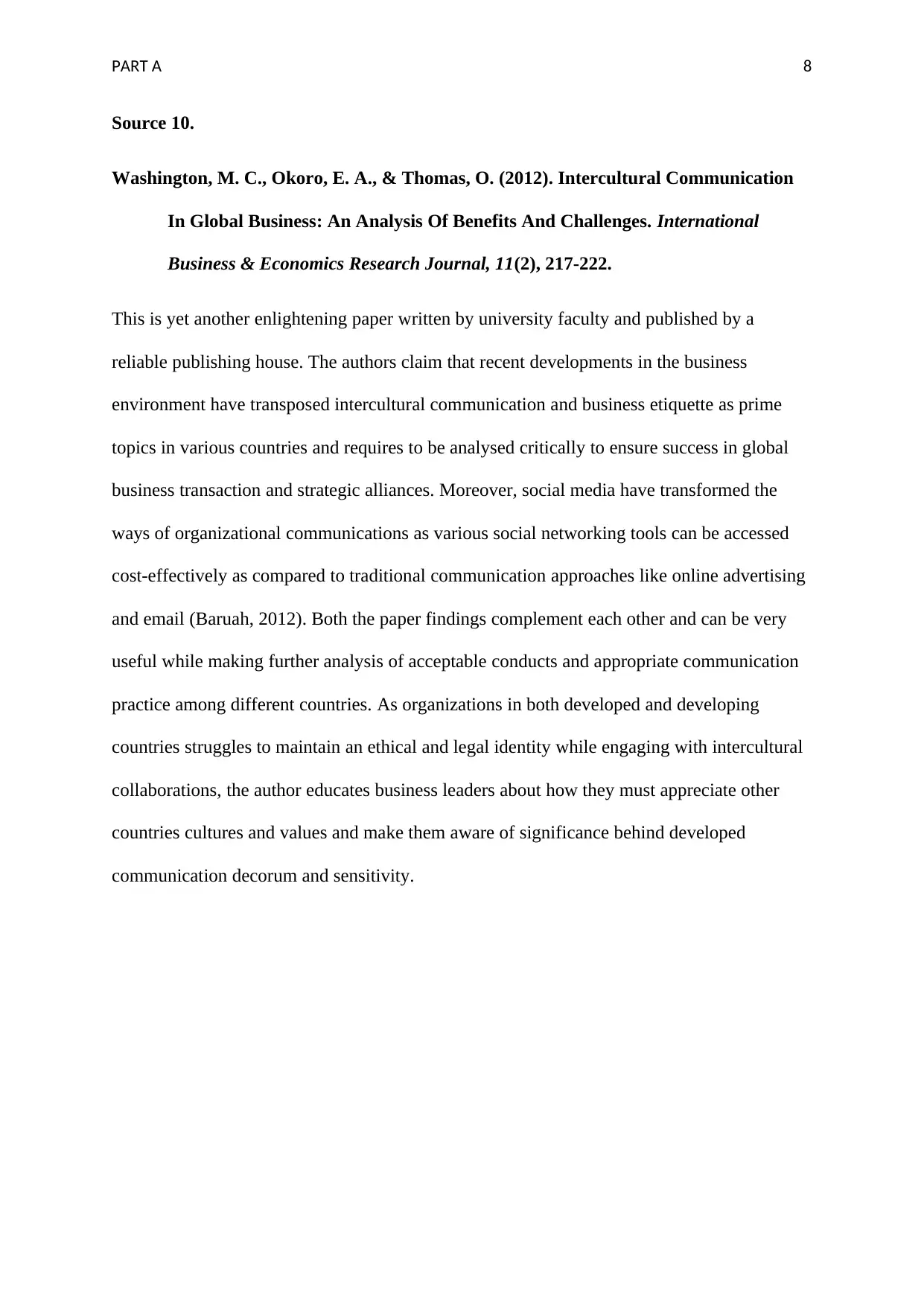
PART A 8
Source 10.
Washington, M. C., Okoro, E. A., & Thomas, O. (2012). Intercultural Communication
In Global Business: An Analysis Of Benefits And Challenges. International
Business & Economics Research Journal, 11(2), 217-222.
This is yet another enlightening paper written by university faculty and published by a
reliable publishing house. The authors claim that recent developments in the business
environment have transposed intercultural communication and business etiquette as prime
topics in various countries and requires to be analysed critically to ensure success in global
business transaction and strategic alliances. Moreover, social media have transformed the
ways of organizational communications as various social networking tools can be accessed
cost-effectively as compared to traditional communication approaches like online advertising
and email (Baruah, 2012). Both the paper findings complement each other and can be very
useful while making further analysis of acceptable conducts and appropriate communication
practice among different countries. As organizations in both developed and developing
countries struggles to maintain an ethical and legal identity while engaging with intercultural
collaborations, the author educates business leaders about how they must appreciate other
countries cultures and values and make them aware of significance behind developed
communication decorum and sensitivity.
Source 10.
Washington, M. C., Okoro, E. A., & Thomas, O. (2012). Intercultural Communication
In Global Business: An Analysis Of Benefits And Challenges. International
Business & Economics Research Journal, 11(2), 217-222.
This is yet another enlightening paper written by university faculty and published by a
reliable publishing house. The authors claim that recent developments in the business
environment have transposed intercultural communication and business etiquette as prime
topics in various countries and requires to be analysed critically to ensure success in global
business transaction and strategic alliances. Moreover, social media have transformed the
ways of organizational communications as various social networking tools can be accessed
cost-effectively as compared to traditional communication approaches like online advertising
and email (Baruah, 2012). Both the paper findings complement each other and can be very
useful while making further analysis of acceptable conducts and appropriate communication
practice among different countries. As organizations in both developed and developing
countries struggles to maintain an ethical and legal identity while engaging with intercultural
collaborations, the author educates business leaders about how they must appreciate other
countries cultures and values and make them aware of significance behind developed
communication decorum and sensitivity.
⊘ This is a preview!⊘
Do you want full access?
Subscribe today to unlock all pages.

Trusted by 1+ million students worldwide
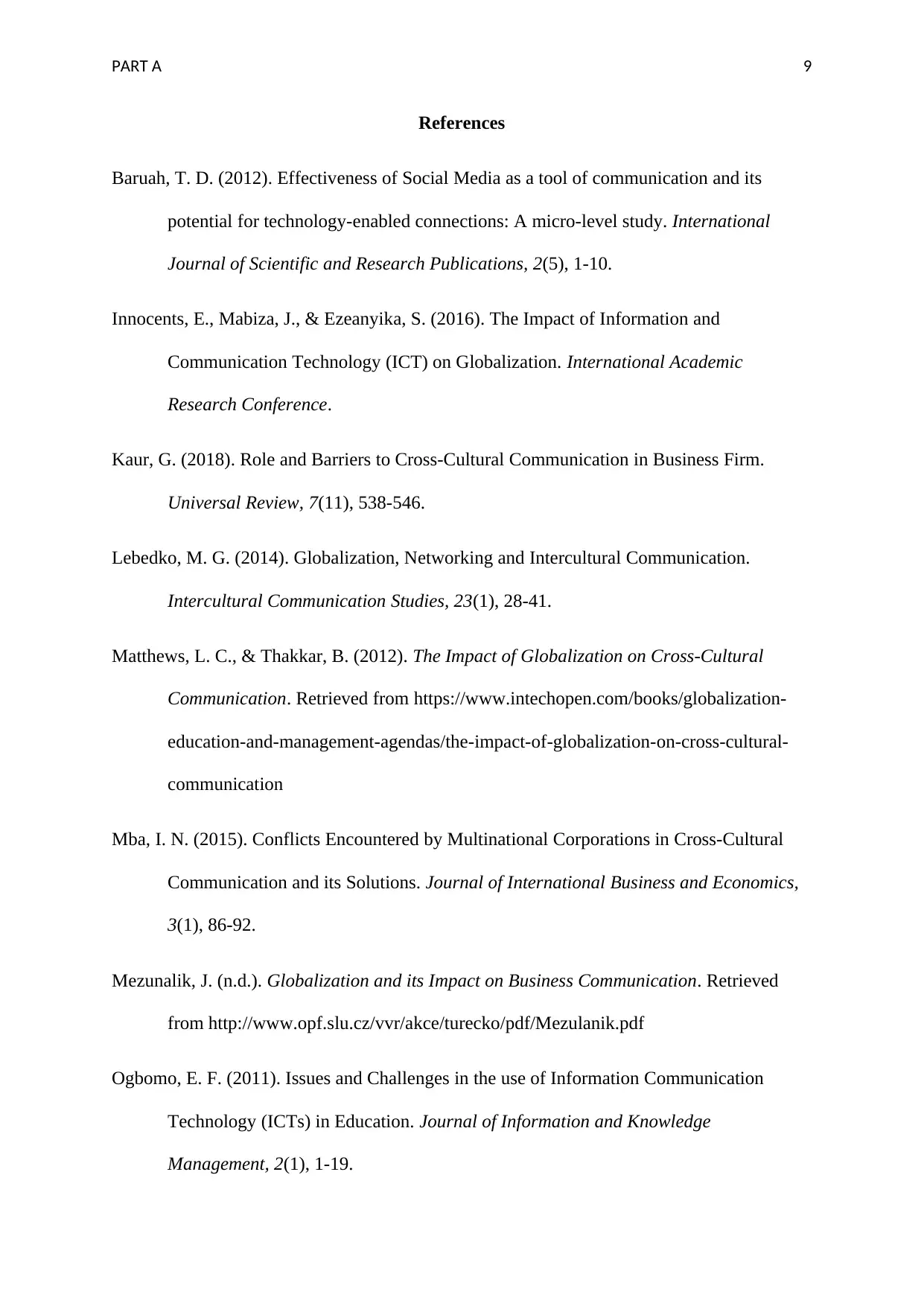
PART A 9
References
Baruah, T. D. (2012). Effectiveness of Social Media as a tool of communication and its
potential for technology-enabled connections: A micro-level study. International
Journal of Scientific and Research Publications, 2(5), 1-10.
Innocents, E., Mabiza, J., & Ezeanyika, S. (2016). The Impact of Information and
Communication Technology (ICT) on Globalization. International Academic
Research Conference.
Kaur, G. (2018). Role and Barriers to Cross-Cultural Communication in Business Firm.
Universal Review, 7(11), 538-546.
Lebedko, M. G. (2014). Globalization, Networking and Intercultural Communication.
Intercultural Communication Studies, 23(1), 28-41.
Matthews, L. C., & Thakkar, B. (2012). The Impact of Globalization on Cross-Cultural
Communication. Retrieved from https://www.intechopen.com/books/globalization-
education-and-management-agendas/the-impact-of-globalization-on-cross-cultural-
communication
Mba, I. N. (2015). Conflicts Encountered by Multinational Corporations in Cross-Cultural
Communication and its Solutions. Journal of International Business and Economics,
3(1), 86-92.
Mezunalik, J. (n.d.). Globalization and its Impact on Business Communication. Retrieved
from http://www.opf.slu.cz/vvr/akce/turecko/pdf/Mezulanik.pdf
Ogbomo, E. F. (2011). Issues and Challenges in the use of Information Communication
Technology (ICTs) in Education. Journal of Information and Knowledge
Management, 2(1), 1-19.
References
Baruah, T. D. (2012). Effectiveness of Social Media as a tool of communication and its
potential for technology-enabled connections: A micro-level study. International
Journal of Scientific and Research Publications, 2(5), 1-10.
Innocents, E., Mabiza, J., & Ezeanyika, S. (2016). The Impact of Information and
Communication Technology (ICT) on Globalization. International Academic
Research Conference.
Kaur, G. (2018). Role and Barriers to Cross-Cultural Communication in Business Firm.
Universal Review, 7(11), 538-546.
Lebedko, M. G. (2014). Globalization, Networking and Intercultural Communication.
Intercultural Communication Studies, 23(1), 28-41.
Matthews, L. C., & Thakkar, B. (2012). The Impact of Globalization on Cross-Cultural
Communication. Retrieved from https://www.intechopen.com/books/globalization-
education-and-management-agendas/the-impact-of-globalization-on-cross-cultural-
communication
Mba, I. N. (2015). Conflicts Encountered by Multinational Corporations in Cross-Cultural
Communication and its Solutions. Journal of International Business and Economics,
3(1), 86-92.
Mezunalik, J. (n.d.). Globalization and its Impact on Business Communication. Retrieved
from http://www.opf.slu.cz/vvr/akce/turecko/pdf/Mezulanik.pdf
Ogbomo, E. F. (2011). Issues and Challenges in the use of Information Communication
Technology (ICTs) in Education. Journal of Information and Knowledge
Management, 2(1), 1-19.
Paraphrase This Document
Need a fresh take? Get an instant paraphrase of this document with our AI Paraphraser
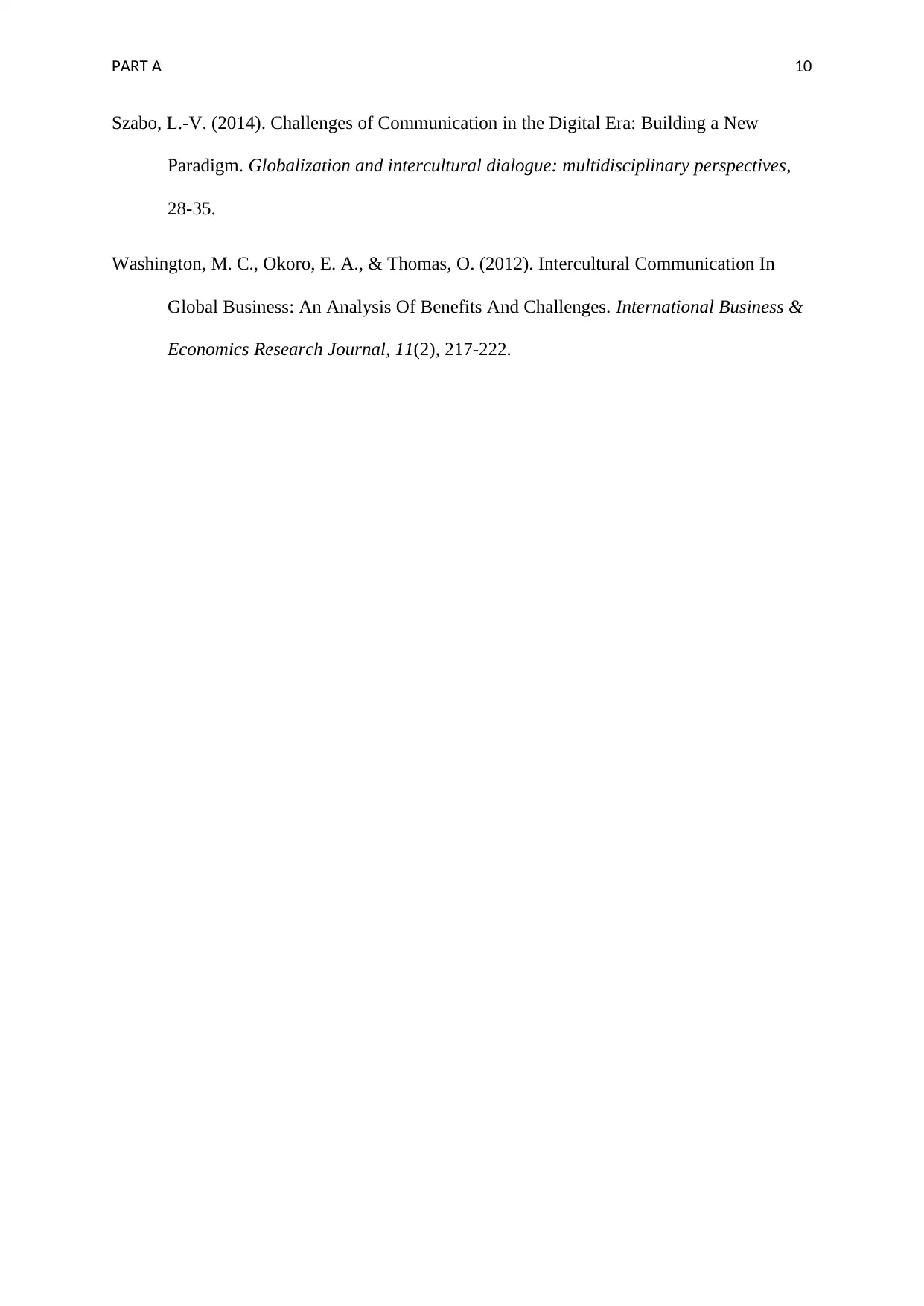
PART A 10
Szabo, L.-V. (2014). Challenges of Communication in the Digital Era: Building a New
Paradigm. Globalization and intercultural dialogue: multidisciplinary perspectives,
28-35.
Washington, M. C., Okoro, E. A., & Thomas, O. (2012). Intercultural Communication In
Global Business: An Analysis Of Benefits And Challenges. International Business &
Economics Research Journal, 11(2), 217-222.
Szabo, L.-V. (2014). Challenges of Communication in the Digital Era: Building a New
Paradigm. Globalization and intercultural dialogue: multidisciplinary perspectives,
28-35.
Washington, M. C., Okoro, E. A., & Thomas, O. (2012). Intercultural Communication In
Global Business: An Analysis Of Benefits And Challenges. International Business &
Economics Research Journal, 11(2), 217-222.
1 out of 11
Related Documents
Your All-in-One AI-Powered Toolkit for Academic Success.
+13062052269
info@desklib.com
Available 24*7 on WhatsApp / Email
![[object Object]](/_next/static/media/star-bottom.7253800d.svg)
Unlock your academic potential
Copyright © 2020–2025 A2Z Services. All Rights Reserved. Developed and managed by ZUCOL.




